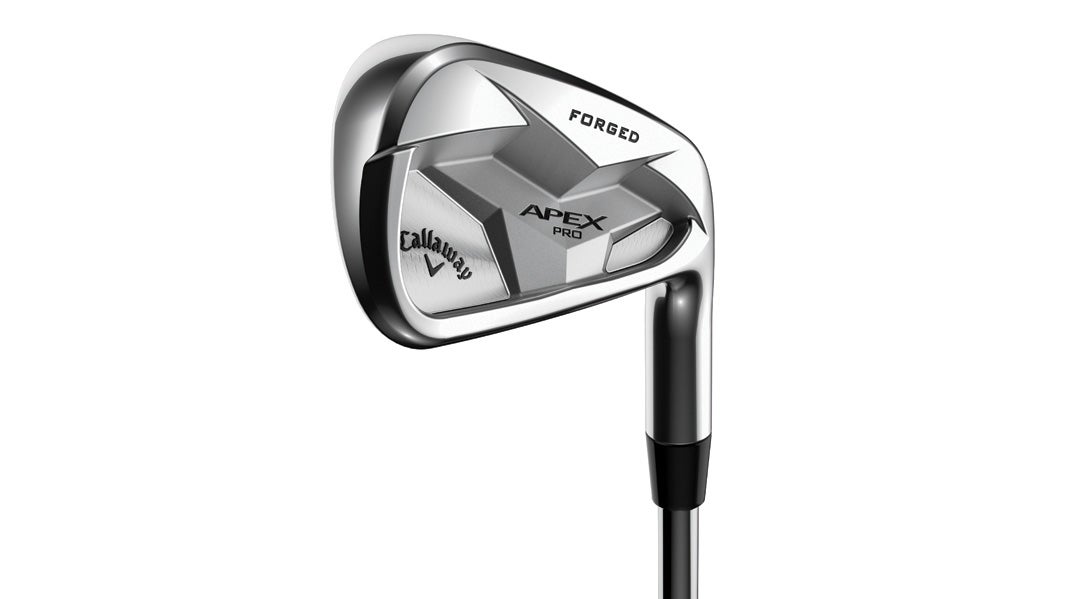Forgiveness isn’t the first thing that comes to mind with a better player iron. Golfers in the 1-6 handicap range are usually looking for some combination of feel, flight and workability. Consistency is the name of the game. That being said, no one is going to turn their nose up at a bit more forgiveness, especially if it comes in a compact package.
As manufacturers continue to push the boundaries of iron technology, it’s no longer necessary to sacrifice mis-hit protection in the name of minimal offset and a consistent ball flight.
The latest edition of GOLF’s 2020 ClubTest spotlight takes a look at 5 better-player irons that offer an impressive level of forgiveness.
Callaway Apex Pro
Callaway Apex Pro
Set: 3-PW
Our take: With a compact shape, Apex Pro is designed for ball-strikers. The bodies are forged from 1025 carbon steel, but they also have urethane microspheres behind the face for a softer feel. The long irons (3-7) offer tungsten weights to lower center of gravity and 360 face cups for higher ball speeds.
ClubTester’s take (6-hdcp): “I want to buy this club right now. Can’t believe the Pro version does it all for me.”
Robot’s take: Testing confirmed that Apex delivers increased ball speed and one of the highest peak heights in the category.
Miura CB-301
Miura CB-301
Set: 4-GW
Our take: Miura’s CB-301 is packed with the kind of forgiveness and speed you’d expect to find in a game-improvement iron. But with a Tour-inspired profile (the shape is slightly larger than the MC-501), it’s able to remain firmly entrenched in the player category at the same time. Consider this Miura’s best-of-both-worlds design. The hand-forged cavity-back features a variable sole and cavity thickness designed to optimize the center of gravity within each head. That means more distance and speed for better players without sacrificing quality and feel. Speaking of quality, each iron undergoes a 14-step manufacturing process before it goes out the door. It’s the kind of meticulous craftsmanship that continues to keep Miura at the iron summit.
Even with Tour-esque shaping, CB-301 is far from your traditional player product. On average, the iron was 1 mph faster and six yards longer than other clubs tested in the category on the robot. Those numbers will make anyone stand up and take notice, especially when it’s paired with forgiveness and a penetrating flight that should speak to those who struggle with too much spin.
ClubTester’s take (5-hdcp): “Feels like this could work for a single-digit or mid-handicapper. Great tweener iron with better-player qualities.”
Robot’s take: Near the top in speed, carry, low spin rate and forgiveness.
Srixon Z785
Srixon Z785
Set: 3-PW
Our take: Made for low handicappers who demand control, the Z785 achieves max workability by placing mass behind the sweet spot. Additionally, the blade-like irons have laser-milled grooves and a Tour V.T. dual-bounce sole design for clean hits from all lies.
ClubTester’s take (1-hdcp): “The club just flows through the turf. Poetry in motion.”
Robot’s take: Delivers impressive carry numbers with a more penetrating ballflight.
TaylorMade P760
TaylorMade P760
Set: 3-PW
Our take: Will please both Tour-level golfers and those who need a bit more forgiveness. The long irons feature a body forged from 1025 carbon steel with SpeedFoam injected in a cavity behind the face to increase speed. The shorter irons, on the other hand, are a one-piece forging.
ClubTester’s take (5-hdcp): “Player iron look with some forgiveness near the top of the set is ideal.”
Robot’s take: A category leader in no fewer than six performance areas, including speed.
Titleist T100
Titleist T100
Set: 3-PW
Our take: No one played a bigger role in the development of Titleist’s T100 than Jordan Spieth, which is a good thing if you happen to be persnickety when it comes to how an iron looks and performs. The slimmed-down profile, thinner topline and reduced offset will catch the eye of a better player (or a multi-time major champion). Just don’t think reducing the overall size means a loss of forgiveness or playability — two things that its predecessor, AP2, was known for. A thinned-out face is paired with dual-density tungsten weights in the heel and toe — 66 grams on average per head — to enhance ball speed and forgiveness. So you’re essentially getting more of everything good from a more compact head shape. The beauty of dual-density tungsten is how it makes even small iron profiles uber-forgiving. Mishits off the toe still produced positive results with the robot, which tells you the multi-material design is doing its job. Not only that, but the overall dispersion pattern was also one of the tightest captured during testing. It’s fair to say T100 hits the right notes.
ClubTester’s take (5-hdcp): “I’d say AP2 underwent a transformational makeover. Iron has sexy curves with game-improvement forgiveness.”
Robot’s take: Tested as one of the most forgiving and consistent irons in the Player Irons category.
